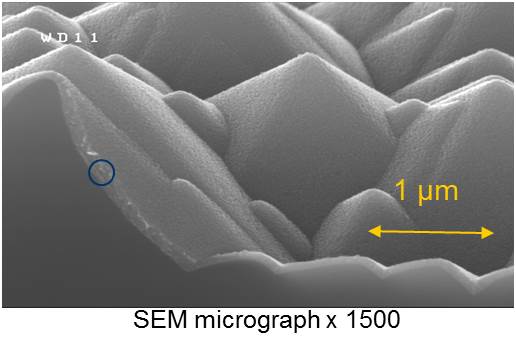Institute Silicon Photovoltaics
Optimisation of wet-chemical conditioning of Si substrates for heterojunction solar cells
A crucial pre-condition to avoid recombination losses of charge carriers on hetero-interfaces is to optimise the wet-chemical substrate pre-treatment. In heterojunction solar cells the a-Si:H layer is used to form the p/n junction. Therefore, the substrate surface directly becomes part of the electronic interface. In textured mono- and polycrystalline substrates which are commonly used to optimise the light trapping properties in Si solar cells, the interface area is increased and consequently interface defects become more and more critical to the quality of subsequent processing like thin oxide film preparation or deposition various passivation layers.
Wet-chemical processes are used in solar cell manufacturing mainly for three purposes:
The recombination losses of charge carriers on Si interfaces are mainly controlled by surface charge, and the density and character of rechargeable interface states Dit . These electronic interface states result from stretched and dangling bond defects localised in a very small interlayer extended over only a few Å. Therefore, the density of these states is strongly related to the surface morphology and micro-roughness.
To reduce interface recombination losses, different approaches are utilised to minimise the density of electronically active defects at the Si interface: (i) removal of damaged regions from the Si surface by wet-chemical smoothing, (ii) saturation of dangling bonds at the surface and near surface region by wet-chemical hydrogen (H‑termination), ultra-thin oxide layers or other substituents, (iii) the engineering of the surface band bending to separate the electronic junction from the crystallographic interface.
In order to evaluate in detail the effect of these processes on the solar cell performance, we investigated standard wet-chemical processes, typically used in solar cell or microelectronic device manufacturing as well as newly developed wet-chemical methods.
Combined application of surface sensitive techniques, the field-modulated surface photovoltage (SPV), ex-situ and in-situ photoluminescence (PL) measurements, atomic force microscopy (AFM), scanning electron microscopy (SEM), spectroscopic ellipsometry in the ultra-violet and visible region (UV-VIS-SE) and Fourier-Transform infrared ellipsometry (FTIR-SE), total hemispherical UV-NIR-reflectance measurements, microwave detected photo-conductance decay (µW-PCD) and quasi-steady-state photo conductance (QSSPC) provides detailed information about the influence of wet-chemical treatments on preparation induced micro-roughness, surface charge, energetic distribution of interface states Dit(E) and the resulting interface recombination behaviour of wet-chemically passivated Si substrates with special surface morphology.
references
- Stegemann, B.; Kegel, J.; Mews, M.; Conrad, E.; Korte, L.; Stürzebecher, U.; Angermann, H.: Evolution of the charge carrier lifetime characteristics in crystalline silicon wafers during processing of heterojunction solar cells. Energy Procedia 55 (2014), p. 219–228
- Kegel, J.; Angermann, H.; Stürzebecher, U.; Conrad, E.; Korte, L.; Stegemann, B.: IPA-free textured a-Si:H/C-Si heterojunction solar cells exceeding 20 % efficiency. In: Proc 28th European Photovoltaic Solar Energy Conference (2013), 2013. - ISBN 3-936338-33-7, p. 1093 - 1098
- Stegemann, B.; Kegel, J.; Mews, M.; Conrad, E.; Korte, L.; Stürzebecher, U.; Angermann, H.: Passivation of Textured Silicon Wafers: Influence of Pyramid Size Distribution, a-Si:H Deposition Temperature, and Post-Treatment. Energy Procedia 38 (2013), p. 881-889
- Laades, A.; Angermann, H.; Sperlich, H.-P.; Stürzebecher, U.; Álvarez, C.; Bähr, M.; Lawerenz, A.: Wet chemical oxidation of silicon surfaces prior to the deposition of all-PECVD AlOx/a-SiNx, Solid State Phenomena 195 (2013), p. 310-313 doi: 10.4028
- Angermann, H.; Wolke, K.; Gottschalk, C.; Moldovan, A.; Roczen, M.; Fittkau, J.; Zimmer, M.; Rentsch, J.: Electronic interface properties of silicon substrates after ozone based wet-chemical oxidation studied by SPV measurements APPLIED SURFACE SCIENCE 258 (2012), p. 8387-8396
- Laades, A.; Sperlich, H.-P.; Stürzebecher, U.; Angermann, H.; Töfflinger, J.; John, W.; Blech, M.; Bähr, M.; Lawerenz, A.:INTERFACE ISSUES OF ALL-PECVD SYNTHESIZED ALOX/SINX PASSIVATION STACKS FOR SILICON SOLAR CELLS Proc. of the 27th EU PVSEC - European Photovoltaic Solar Energy Conference and Exhibition Frankfurt / Main, Germany, 14.09.2012 - 18.09.2012 (2012) pp. 888 - 895
- Wolke, K.; Gottschalk, Ch.; Rentsch, J.; Angermann, H.: Ozone based chemical oxide growth for crystalline solar cell production.Solid State Phenomena 187 (2012), p. 321-324
- Angermann, H.; Rappich, J.: Wet-Chemical Conditioning of Silicon Substrates for a-Si:H/c-Si Heterojunctions. In: van Sark, W.; Korte, L.; Roca, F. [Eds.] : Physics and Technology of Amorphous-Crystalline Heterostructure Silicon Solar cells. Berlin: Springer, 2012 (Engineering Materials). - ISBN 978-3-642-22274-0, p. 45-94
- Heike Angermann, Orman Gref und Bert Stegemann, Effect of wet-chemical substrate smoothing on passivation of ultrathin-SiO2/n-Si(111) interfaces prepared with atomic oxygen at thermal impact energies Central European Journal of Physics,Volume 9, Number 6, (2011) 1472-1481,
- Wolke, K.; Gottschalk, Ch.; Moldovan, A.; Oltersdorf, A.; Angermann, H.: Ozone based chemical oxide growth for crystalline silicon solar cell production. In: Ossenbrink, H. [u.a.] [Eds.] : 26th European Photovoltaic Solar Energy Conference 5 - 9 September, Hamburg, Germany. München: WIP, 2011. - ISBN 3-936338-27-2, p. 839-842
- Angermann, H.; Wünsch, F.; Kunst, M.; Laades, A.; Stürzebecher, U.; Conrad, E.; Korte, L.; Schmidt, M.: Effect of wet-chemical substrate pretreatment on electronic interface properties and recombination losses of a-Si:H/c-Si and a-SiNxH/c-Si hetero-interfaces. Physica Status Solidi C 8 (2011), p. 879-882 doi:10.1002/pssc.201000236
- H. Angermann, Passivation of structured p-type silicon interfaces: Effect of surface morphology and wet-chemical pre-treatment, http://dx.doi.org/10.1016/j.apsusc.2008.03.022, Appl. Surf. Scie. 254 (2008), pp. 8067-8074
- Laades, A. ; Brauer, J. ; Stürzebecher, U. ; Neckermann, K. ; Klimm, K. ; Blech, M. ; Lauer, K. ; Lawerenz, A. ; Angermann, H.: Wet-Chemical Treatment of Solar Grade CZ Silicon Prior to Surface Passivation. In: 24th European Photovoltaic Solar Energy Conference, EU PVSEC ; proceedings of the international conference, held in Hamburg, Germany, 21 - 25 September 2009. Munich: WIP, 2009, p. 1640-1644
- Angermann, H. ; Schulze, T.F. ; Conrad, E. ; Rappich, J. ; Korte, L. ; Schmidt, M.: Cleaning and passivation of structured n-type Si substrates: preparation and interface properties of a-Si:H/c-Si hetero solar cells. In: Lincot, D. [u.a.] [Eds.] : Twenty third European Photovoltaic Solar Energy Conference : proceedings of the international conference held in Valencia, Spain, 1 - 5 September 2008. München: WIP Renewable Energies, 2008. - ISBN 3-936338-24-8, p. 1422-1426

